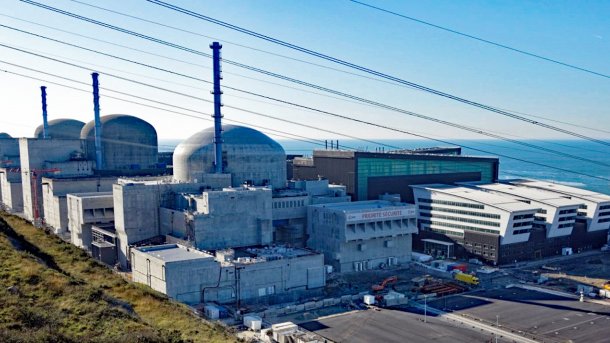Nuclear power: EDF may load Flamanville 3 and must change reactor cover
After delays, the French nuclear regulator gives the green light for the new EPR - with conditions.

The three units of the Flamanville nuclear power plant, the newest one in front.
(Bild: EDF)
The French nuclear regulator ASN has approved the operator of the Flamanville nuclear power plant to load the new EPR with fuel rods, subject it to start-up tests and connect it to the grid. At the same time, it requires the operator EDF to replace the reactor's cover for the first fuel change in 2026. Weaknesses in the steel were discovered years ago. For the time being, the nuclear regulator does not now consider these to be an obstacle to starting operation.
EDF had originally wanted to load the reactor with fuel in March of this year, but the process was not yet approved. However, the ASN (Autorité de sûreté nucléaire) called for a public consultation on its approval for the reactor's commissioning before making a final decision. This ran until mid-April and prompted the ASN to attach further technical conditions to the approval in addition to the replacement of the reactor cover.
This delayed the original schedule by a good month. EDF had assumed that Flamanville 3 would be able to go online in the middle of this year. The reactor was actually due to go online twelve years ago. The construction costs add up to 13.2 billion euros; the original estimate was 3.3 billion euros. According to the ASN, 600 inspections were carried out at the reactor construction site.
Third generation reactor
Once the reactor is loaded, a test phase will follow during which the output will be gradually increased. During the tests, ASN will check whether the safety regulations are being adhered to, for example when the main primary circuit has reached a temperature of 110°C. When the reactor runs at 25 percent of its maximum power, the reactor protection system is checked.
The EPR is a third-generation reactor, after the first, which consisted of early prototypes, and the second of commercial reactors such as the light water reactors in Germany. EPRs are a further development of the second generation reactors with more power, reliability and safety. An EPR was connected to the grid in Olkiluoto, Finland, a year ago, also with a long delay, namely 14 years, and also with a quadrupling of the originally estimated costs. The Hinkley Point C EPR, which is currently being built in the UK, will also be delayed and more expensive.
(anw)